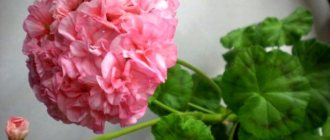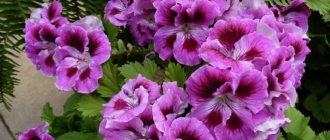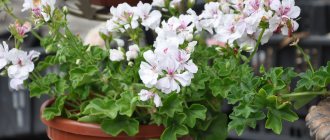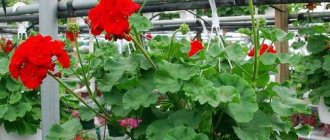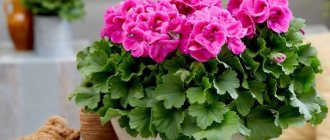Royal geranium is the fruit of many years of painstaking work by breeders. It differs from other similar varieties in its delicate delicate aroma and large size of flowers, which form a cap above the green leaves. It is also known as Grandiflora. This plant looks simply gorgeous; every gardener dreams of having such a luxurious beauty. However, it is worth remembering that large-flowered royal geranium is very capricious and difficult to care for.
This variety of pelargonium has not only an interesting history, but also a number of distinctive features by which it can be easily recognized.
Royal geranium is very difficult to grow, but its chic appearance and delicate delicate aroma compensate for all the inconvenience and costs
It got its name due to its chic appearance during the flowering period. However, in order to achieve the desired result, you need to put in a lot of effort.
What does it look like
The height of an adult plant does not exceed 0.5 m. The flowers are located at the same level as the leaves. The diameter of the inflorescence reaches 15 cm. The color range is very rich: from snow-white to almost black. The most common color palette is red. The upper row of inflorescences is characterized by a more saturated color, sometimes even with a spotted pattern. In appearance, the flower is very similar to a pansy. Particular attention should be paid to the Elegance variety, which is considered the elite. The non-uniform color of the flower cap immediately attracts attention and attracts glances.
Flowers are large in size
The leaves of the royal geranium are velvety, their edges are wavy. Their color is green. The stem is erect. The root system consists of adventitious roots.
Description
Royal pelargonium, or otherwise domestic, was bred by English breeders . The progenitors were the large-flowered and glomerular varieties. Royal pelargonium is not a variety, but a variety that has a huge number of varieties.
The main difference between this noble beauty is its large flowers, collected in an umbrella, 5-7 cm in diameter. Some varieties have fringed edges of the petals. The color is very diverse from white and soft pink to burgundy and purple. The color variety lacks only blue-blue and yellow shades.
Most varieties of royal pelargonium have dark spots on the top two petals , as well as dark veins along the remaining petals. This feature makes it look like a viola (pansy). The leaves of the queen pelargonium are also special - their edges are not outlined in smooth waves, but have a jagged structure. The bush is compact, from 40 to 60 cm. There are varieties with small flowers and a small bush up to 30 cm. They are called angelic pelargoniums.
ATTENTION : The striking feature of this flower is its peculiar pungent smell, however, some varieties exude the aroma of apple or rose, or have no smell at all.
Royal geranium care for beginners
Royal geranium - conditions for flowering
A very capricious plant is the royal geranium. Proper care at home for beginners is a big problem. The plant needs special care, so you should familiarize yourself with all the rules and nuances in advance.
Royal pelargonium is capricious in care
Temperature
Royal pelargonium is a heat-loving plant species. In summer, in the climate of the middle zone, it can be kept outdoors at +22-27°C. If this indicator increases, you should water the flower twice a day. The first time this is done before 10 a.m., the second time after 6 p.m.
In winter, the air temperature in the room where royal geranium grows should be maintained at 10-15°C. You can take the pot to a heated loggia or to a greenhouse, but the amount of light should not decrease. A cool window sill with a wooden frame is also suitable for the plant.
Lighting
Geranium loves good lighting, but at the same time requires protection from direct sunlight. With a lack of light, the flower stems become elongated and the leaves become pale in color. It is best to place royal pelargonium on an eastern or western windowsill. If you grow it on a south-facing window, you need to take care of a little shading.
Well-lit places are suitable for growing geraniums.
Watering
Irrigation rates are adjusted depending on temperature and time of year. In summer, when the weather is dry and hot, geraniums are watered 2 times a day. If the flower is kept in a room, then irrigating it 1-2 times a week is enough. In winter, the plant should be watered once a week. Before carrying out the procedure, inspect the earthen lump and make sure that it has had time to dry out.
Attention! If overwatered, royal geranium begins to suffer from powdery mildew and root rot.
Spraying
Spraying of geraniums is carried out only if the air in the room is dry or the central heating radiators are running. You should not be overzealous with this procedure, otherwise fungal diseases may develop.
Humidity
Royal geranium prefers high humidity conditions for growing, but this indicator directly depends on the air temperature in the room.
Priming
You can buy soil for growing royal geranium at a flower shop or prepare it yourself. Its acidity should be neutral, and the composition includes moisture-retaining components (for example, sphagnum).
Royal geranium prefers slightly alkaline soil with a neutral acidity level.
Attention! If the soil is dense, then before planting the flower it is enriched with perlite.
The soil for pelargoniums should be loose and contain a sufficient amount of nutrients. You can prepare it by mixing the following ingredients:
- leaf humus;
- peat;
- sand;
- a small amount of wood ash.
Feeding
Royal pelargonium is grown in cramped pots, so the plant can survive without replanting for several years. Over time, the soil becomes depleted and must be fertilized. In early spring it is worth feeding with a high nitrogen content. With the beginning of flowering, priority is given to phosphorus. To achieve lush flowering, start feeding geraniums in March and stop in September.
Attention! Abuse of fertilizing in winter negatively affects the flowering of royal pelargonium.
Excessive use of fertilizers can harm geraniums
Care in winter, during the dormant period
Winter is a dormant period for geraniums. As soon as the plant has had time to bloom, it should be removed to a cool place with a temperature of 10-14°C, and the amount of watering should be reduced to a minimum. No feeding is needed at this time.
Attention! To ensure more luxuriant color next season, geraniums should be pruned before the dormant period begins.
During the pruning process, the main stem is shortened by a third, and all dry or damaged shoots and leaves are removed. Shoots that appear in winter are pinched.
Common diseases
Diseases for royal pelargoniums pose a greater danger compared to other species. The table shows the most common ailments and methods of treating them.
Table - Diseases of royal pelargoniums
| Name of the disease | Signs of infection | Treatment methods |
| Gray rot | — Brown spots on the leaves; - gray fluffy coating | — Transplantation into new sterile soil; - pruning of affected parts; – treatment with fungicides “Vitaros”, “Fundazol” |
| Stem and root rot | — Blackening of the root collar; - pallor, yellowness, lethargy of leaves | Treatment with “Fitolavin”, “Biporam” |
| Late blight | — Growth slowdown; - pallor of leaves; - depressed spots on stems | — Trimming to healthy tissue; - treatment with any fungicides; - transplantation into a sterile substrate |
| Edema (tissue swelling) | Lumps and growths on leaves | — Trimming diseased leaves; - reduction of watering |
| Verticillium wilt | The leaves fade, but remain hanging on the stem | — Destruction of affected plants; — at the initial stages - treatment with the preparations “Fundazol”, “Topsin” |
The main pests are spider mites, aphids, and whiteflies. To combat them, insecticides and acaricides are used. For minor damage, a single treatment is sufficient. If it is strong, you have to re-process it.
When and how does it bloom
Royal begonia (Begonia Rex) at home
The flowering of royal geranium causes true delight among gardeners. She can not only look great, but also exude an amazingly subtle aroma.
Types of flowers
Royal geranium flowers can be not only classic, but also double. There are even specimens with corrugated inflorescences. The variety of their colors is simply amazing. The following shades can be presented:
- yellow;
- pink;
- red;
- violet;
- orange;
- white.
Royal geraniums have a rich range of colors
Flower shapes
The royal flower mostly has flat and concave petals on the inflorescences, but in some varieties they are wavy. This makes the plants even more attractive and sophisticated.
Flowering period
Unlike other varieties, royal geraniums do not have such a long flowering period. Its duration does not exceed six months. The beginning of flowering coincides with the onset of spring.
How to make it bloom at home
In order for royal geranium to bloom at home, its pot must be a little cramped. The plant also needs a period of rest. Otherwise, it will weaken and will not drown in flowers in the next season. Timely application of fertilizers, normalized watering and sufficient lighting levels are also necessary conditions for flowering.
Pruning for lush flowering
Before the onset of the dormant period, the main stem of royal geranium is shortened by a third of its length. This helps maintain the decorative appearance of the flower and also improves air circulation, which prevents the spread of fungi and pests.
Mandatory pruning is required for lush flowering.
In spring, only thin and non-viable shoots are pruned so that the flower does not waste energy on them. This is done in such a way that at least 4 internodes remain on the shoot. You can also form a standard from the plant, but in this case the fragile stem will have to be attached to a support.
Useful qualities of the plant
Geranium oil is made from the described flower, as well as additives for flavoring medicines. At home, it is used to treat radiculitis and osteochondrosis, eliminate headaches and disinfect air. The bush is especially effective in the fight against streptococci and staphylococcus. 3-4 hours are enough to completely disinfect the air.
The aroma of the flower eliminates unpleasant odors in the room, relieves fatigue and irritability, and normalizes sleep. If your blood pressure drops due to emotional overload, just sit next to the bush and inhale its aroma. In a few minutes the pressure will return to normal. To improve sleep, dried leaves are placed in a linen bag: you need to put it next to the pillow.
An unpretentious and beautiful plant, geranium will not only delight its owners with lush inflorescences and a pleasant aroma, but can also become a real green pharmacy in the house. To maintain the attractiveness and health of the bush, it is enough to trim it regularly and observe the wintering conditions.
How does royal geranium propagate?
There are several proven methods for propagating royal geraniums, which are actively used by experienced flower growers and breeders.
Germination of seeds
Germinating seeds takes longer than just rooting a cutting. But the grown plants will be healthy and strong, and their flowering period will be longer.
Attention! It is impossible to prepare royal geranium seeds yourself, since each variety is a hybrid and, after germination, does not retain the characteristics of the mother plant.
Seed material can be purchased from a reliable and trusted flower shop. The seeds are carefully distributed over moist soil (which necessarily includes sand and perlite), sprinkled with sand on top and slightly buried. The vessel is covered with cellophane or glass and placed in a warm, well-lit place. Direct sunlight on crops is unacceptable. When real leaves appear on the young geranium, it is planted in separate pots. After the fifth true leaf is formed, the plant is pinched.
Rooting cuttings
To propagate by cuttings, use the upper sprouts, the length of which is about 8 cm. Each of them must have at least 2 internodes. Within a couple of hours after pruning, they are allowed to dry and planted in prepared soil, having previously been treated with any root formation stimulator. The cutting is buried 2 cm and placed in a room with a temperature of about +18°C and not very bright lighting.
Attention! To prevent the cuttings from rotting, water them through a tray.
It is best to propagate geraniums from cuttings
Geranium takes root within a week, after which you can plant it in separate pots.
Air layering
This method of propagation is very similar to rooting cuttings. Next to the pot of royal geranium, another container with nutritious soil mixture is placed. Select a suitable strong branch and bend it to the installed container, after which it is fixed with a metal bracket and sprinkled with soil. The soil is tamped down a little and watered. After a week, roots should form. When the new plant begins to develop independently, it is cut off from the mother bush and planted in its own pot.
Attention! It is not recommended to use a cheap Chinese pot for growing royal geraniums, since in it the plant is more often susceptible to disease.
Pelargonium: reproduction
Geranium is considered one of the most tenacious also because it is easy to propagate. Even a small cutting can be rooted quickly enough with plain water. Moreover, the method completely conveys the properties of the mother plant, while the seed method does not guarantee this.
Important: the best period for rooting is August-September. Roots also form at other times of the year, but the process will just take longer and the plant will be weaker.
The cuttings are cut at an acute angle, at least 5 cm below the nearest internode. For dwarf species, a sprout of up to 8 cm is enough for it to become viable. But a cutting of any length can take root, the main thing is that there is no woodiness on the trunk.
Remove the buds from the future seedling and the lower leaves so that they do not take up extra resources and rot. Any root will help speed up the process.
There is an opinion that rooting through water has a high probability of plant rotting and death, so it is better to plant immediately after cutting in a damp mixture of peat and sand under non-woven fabric for 3 days.
Transfer
For several years, royal geranium can grow quietly in one pot. In addition, it is painful to transplant into open ground in the summer, unlike other varieties. The procedure is carried out only when the root system has completely filled the planting container. The new pot should be 1.5 cm larger than the previous one. A pot that is too large will slow down the growth of the flower and cause a prolonged absence of flowering.
Attention! Due to frequent transplants and changes in location, royal pelargonium may die.
Royal geranium does not tolerate frequent transplants
It is better to plan geranium transplantation work for the period from February to April. Having emerged from the dormant period, the plant takes root well and enters the active growth phase. In summer and winter, unless absolutely necessary, you should not disturb the flower.
Pruning rules
How to prune a plant? It is necessary to prune royal pelargonium to maintain the beautiful shape of the bush and full flowering. A common mistake is spring pruning. If you prune pelargonium in the spring, it will delay flowering for a year. Therefore, you need to form a bush only after flowering has finished. Usually it ends in mid-summer, sometimes a little later.
Pruning is carried out twice at monthly intervals. After the first pruning, pelargonium will actively produce new shoots. To stimulate further branching, they are pinched after the fifth young leaf. Pinching is repeated up to five times to achieve a neat bush shape and active formation of buds. The last pinching time is no later than the end of January.
If the pelargonium has grown greatly during wintering, instead of pinching the shoots, you can trim them a little.
Possible problems in growing
Even the most experienced gardeners are not one hundred percent protected from the problems that arise when growing royal geraniums. It's even more difficult for beginners.
Drops buds and leaves
If the leaves and buds of the royal geranium begin to fall off, then with a high probability we can say that the room is too hot and the air is very dry. Also, these symptoms sometimes indicate insufficient lighting. You will need to turn on the phytolamp, install a humidifier and take measures to reduce the temperature in the room. If the house is cool, then it is enough to limit yourself to additional lighting and monitor the humidity.
Due to the heat, the royal geranium sheds its leaves and buds
The leaves are turning pale
A change in the color of the leaf blade is provoked not only by a deficiency of microelements (in particular nitrogen), but also by a lack of light, as well as excess moisture. It is urgent to analyze these factors and eliminate the cause.
The tips of the leaves are drying out
This problem in royal geranium most often occurs due to moisture deficiency. You should increase the number of waterings and resort to air humidification, but you should not be too zealous.
The lower leaves fall off
The fact that the lower leaves begin to turn yellow and fall off is caused by both a lack of moisture or nutrients in the soil, as well as a lack of light and poor ventilation of the bush. This symptom also signals rotting of the root system, which can lead to the death of the flower.
Pests
The most dangerous pests for royal geraniums are:
- mite;
- weevils;
- whitefly;
- aphid.
Royal geranium is susceptible to pests
To get rid of parasites, you should wipe the inside of the leaf blade with chamomile infusion and leave the plant for a couple of hours, then rinse everything off. If such actions do not bring a positive result, use an insecticide. Step-by-step instructions for its use are contained in the attached documentation.
Other problems
Sometimes the trunk of the royal geranium begins to rot. This indicates that the plant is affected by blackleg. The development of this disease is caused by excessive watering or low temperatures. Sick plants need to be disposed of and the pot disinfected.
Sometimes gardeners wonder why geraniums are green but lethargic? First of all, you should immediately reduce watering. Otherwise, the flower will bleat with gray rot. The scarlet tint of the leaves indicates low temperatures or the presence of drafts.

